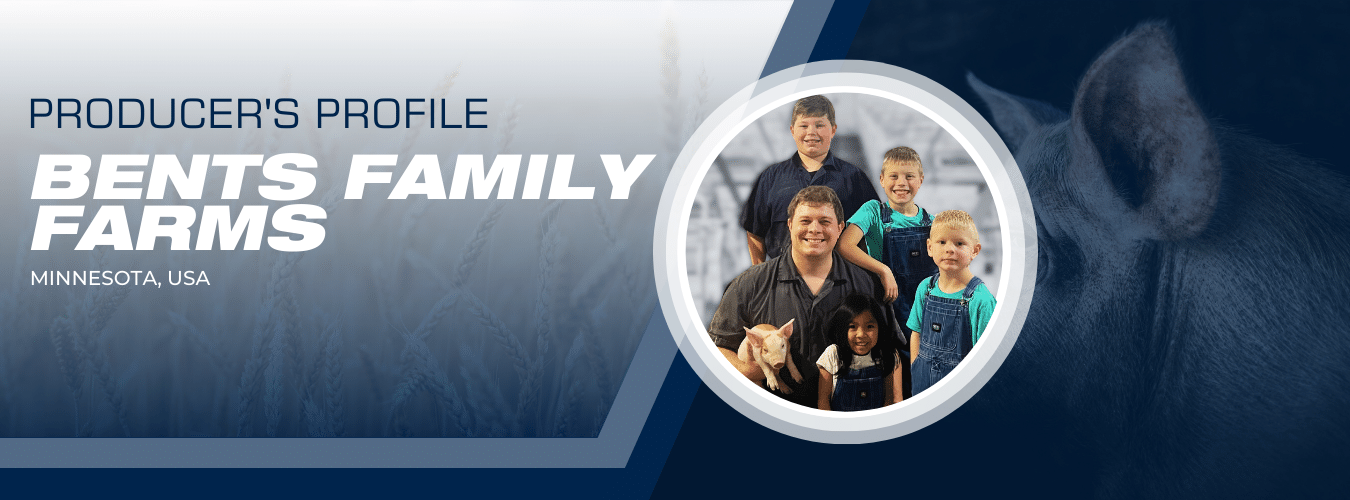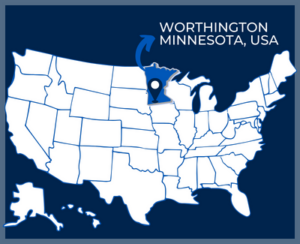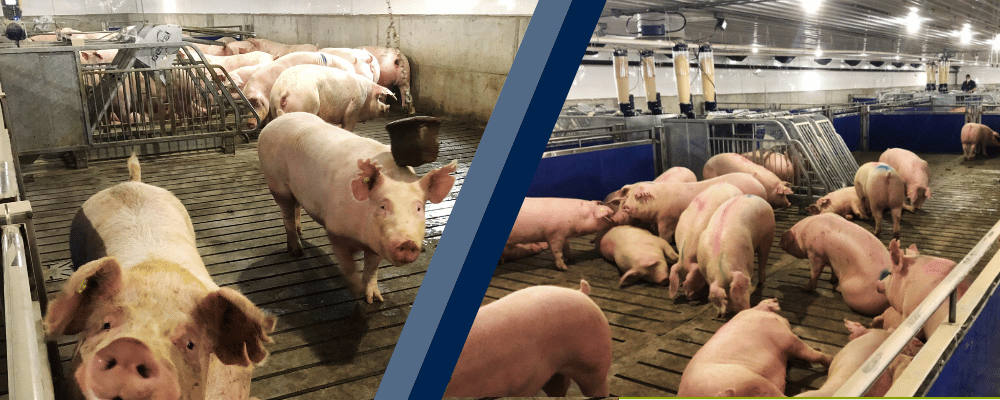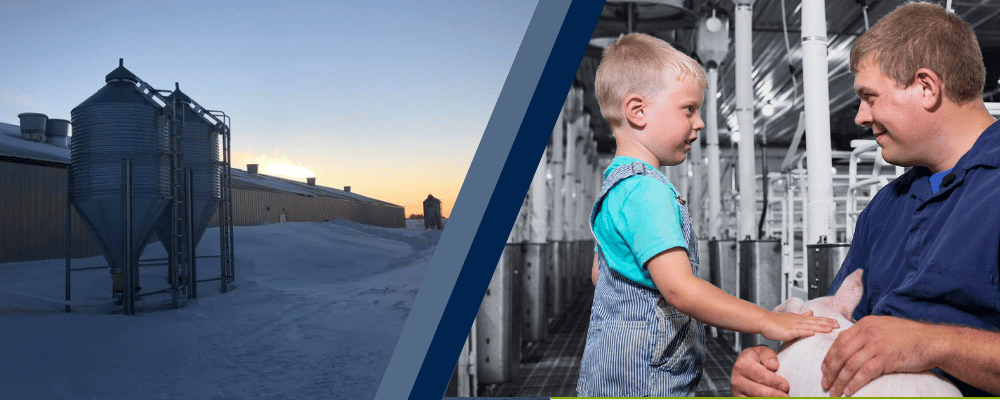Modern Pig Farm Embraces Tradition and Technology
Technology aids pig-farming family’s quest for high-quality animal welfare and superior product
By Brandi Buzzard for Jyga Technologies
Much has changed since Dr. Andrew Bents’ great-great grandfather would ship a rail car full of pigs from southwest Minnesota to Omaha twice per year. The farm has changed dramatically since then in terms of production, facilities and labor needs. However, two aspects of the farm have remained steadfast for more than a century: animal welfare and efficiency have been, and always will be, a focus of the farm’s long-term goals.
OWNERS:
The BENTS Family
Worthington, Minnesota, USA
FARM’S FEATURES:
• 340-head sow farm
• Farrow-to-Finishing
• Group-housing gestation with GESTAL 3G
Bents, a swine veterinarian with Hubbard Feeds, and his wife, Jenna, are part of the fifth generation to own and manage Bents Family Farms near Worthington, Minnesota.
“Our farm has never not utilized group housing,” explained Bents. “My family still owns the pasture where my grandpa raised sows.”
When Bents’ father and uncle bought into the operation in the 1980s, they converted an outgrown machine shed into their gestation barn, installing group pens to accommodate the herd. Using lumber and trusses salvaged from an old house on the property, they also constructed a new farrowing house nearby. Additional pens were added in an old dairy barn at his uncle’s farm, allowing peak production of 120 sows in the partners’ farrow to finish operation.
Thirty-some years later, the farm has been modernized once again, and now accommodates 340 sows, while embracing its origins of group housing for farrow-to-finish.
Modernizing History
Bents, his father and his brother-in-law broke ground on the new unit in 2018 and moved gilts into the new facilities in 2019. As Bents was deciding what kind of technology and improvements to make on the new unit, he toured other farms to see what they were using and how their facilities were designed. He was very impressed with individualized feeding systems and the management control they afforded, as well as their ability to keep Bents’ animal welfare goals at the forefront.
GESTAL 3G Is the Solution
Bents chose to install GESTAL 3G, a free access electronic sow feeders (ESF) because they integrated very well into his production philosophy, had fewer moving parts and were relatively simple. Once he met the U.S. Jyga team, Bents said he was fully on board.
“Prior to installing GESTAL 3G, we were floor feeding once per day and bedding with straw in the old barn,” Bents said. “That required an incredible amount of labor because the pens required cleaning every 2-3 days, daily in the feeding area,” he added.
“Now that we have the 3G system, care for the sows has been simplified and we are able to maintain a much more consistent body condition across the group. When we were floor feeding, it was common to have pens with fat and skinny sows, which was very difficult to manage. Now, correcting body condition requires only a push of a button at the computer.”
Bents, a staunch advocate for high-level animal husbandry, insisted that the GESTAL 3G feeders have also opened doors to other intangible benefits in the unit that aren’t often discussed.
Once they moved into the new unit, labor demands immediately decreased due to slatted floors over a deep pit which only requires pumping once per year. Bents, his family and part-time employee also appreciate not having their knees under as much stress from going in the pens with pushy sows to floor feed every day. Furthermore, slatted floors have eliminated the labor costs of growing and putting up enough straw to bed the sows throughout the year as well.
But no change is without challenges. The aftereffects of COVID-19 laid bare many weak points in the industry, which had previously been workable. Uncertainty surrounding input costs, market pricing, labor management and health has only increased over the last four years, especially.
However, Bents was able to address many of these challenges with the new unit, which is substantially more secure than previously.
“In our old sow barn, birds and cats had free access, making biosecurity impossible to manage. Our new unit is so much more biosecure – it’s shower in, shower out, power ventilated and we have short-term plans to install an air filtration system.”
Success Stories for Generations
Bents is proud of his family’s heritage and generational farming roots. A fifth-generation farm doesn’t happen by accident, it happens through dedication, sacrifice, faith and hard-work. Bents said his biggest accomplishment on the farm is carrying it on for another generation.
“We were at a critical point where we had to decide if we were going to sell the sows or continue farrowing. For us to have started the process to continue farrow to finish production for another generation gives me a great sense of pride.”
He also points to improvements in production methods and technology when he considers successes. Over the decades, the farm moved away from boar breeding in favor of artificial insemination, which improved conception rates and reduced their 3-week farrowing window to only 5 days. Additionally, Bents increased the herd from a two group, 10-week batch, to a five group, 4-week batch farrowing system. In short, small changes over time have multiplied to large impact.
“We can operate 340 sows with less labor than my dad and uncle required to manage 120 sows. When my grandfather was raising pigs, weaning 16 pigs per sow per year was a respectable achievement. We’re on track to produce 32 pigs per sow per year in my lifetime. In two generations, we have nearly doubled our sows’ output,” Bents explained.
Precision feeding has been integral in the success Bents has experienced. He attested that feed costs are so much easier to track and control with the 3G feeding systems.
“I know how much every single sow eats every day, which makes booking ingredients a more streamlined process. I can also manage body condition to a narrow range, which makes planning feed usage more efficient. For example, if I identify that body condition in the herd is above target, I can cut down a tenth of a pound per day on our feed curve, and save significant input costs. I could never be that precise with floor feeding.”
For Love of the Farm
Bents is the first to say it hasn’t been easy – their farm is an outlier when it comes to production philosophy and marketing. Group housing carries a stigma of potential reduced productivity and increased labor demand. Contrary to this belief, Bents’ herd runs about 20% of the national average in sow mortality.
“We hear people say that group housing can contribute to increased lameness and sow mortality, but that hasn’t been the case for us. If you understand the animals, you can manage them well in any kind of system,” Bents insisted.
“We love the way we raise pigs here on our farm – we believe we’re raising pigs the way they should be raised. But at the end of the day, we must make a profit, because while we do enjoy what we do, we aren’t doing this purely for fun. Profitability is important but not worth sacrificing the well-being of the people and animals on the farm; I’m not willing to accept a high mortality rate in the name of higher profitability. I’m not willing to accept a poor-quality end product to drive down production costs.”
In the short term, Bents’ biggest goal is to get through the first year of full ownership with his wife, Jenna, following the transition from Bents’ father, and “survival” is at top of mind right now. But moving beyond that, Bents has a dream to increase the size of the sow herd in a way that enables him to maintain his production philosophy, while also keeping it exciting and interesting for his children, nieces and nephews.
“We take pride in our product and in raising animals how we feel they should be raised,” Bents said. And he credits GESTAL as one of the tools he’ll use to meet those future goals.
ASK FOR GESTAL
For more information on GESTAL smart feeding systems, contact our team.
With 30 years of experience in swine production, we know your reality. GESTAL products are sold worldwide, including Canada, the United States, Latin America, Europe and Asia.







